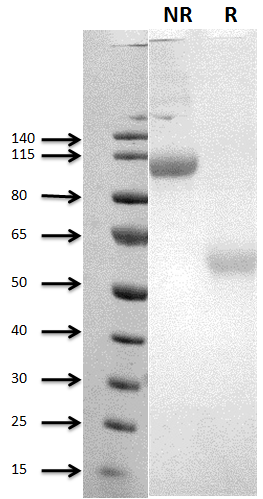
| Catalog Number | Product | Size | Price | |
|---|---|---|---|---|
| P1012-200 | Recombinant Human CD47 Fc Chimera Protein | 200 µg | $199 | Order |
| P1012-500 | Recombinant Human CD47 Fc Chimera Protein | 500 µg | $299 | Order |
| P1012-B | Recombinant Human CD47 Fc Chimera Protein | Bulk | Inquire |
| Source: | Human CD47 (Accession#AIC61946) extracellular domain (Gln19 – Pro 139) fused with human IgG1 Fc produced from HEK293 cells. |
|---|---|
| Structure: | Disulfide-linked homodimer |
| Predicted N-terminal: | Gln 19 |
| Predicted Molecular Weight: | 39.6 kDa, reducing conditions |
| Apparent Molecular Weight on SDS-PAGE: | 55 kDa, reducing conditions |
| Formulation: | 0.22 µm filtered protein solution in 1x PBS |
| Storage: | < -20°C |
| Estimated Purity: | >95% as determined by SDS-PAGE |
| Protein Endotoxin Level: | Not measured |
| Protein Aggregation: | <5% as determined by SDS-PAGE |
| Application: | Bioassay (biochemical assay) |
|---|---|
| Product Description: | CD47 is a 40-60 kDa variably glycosylated atypical member of the
immunoglobulin superfamily (1, 2). Human CD47 is an integral membrane
protein that consists of a 123 amino acid (aa) extracellular domain (ECD)
with a single Ig-like domain, five membrane-spanning regions with short
intervening loops, and a 34 aa C-terminal cytoplasmic tail (3).
Alternative splicing of human CD47 generates additional isoforms with deletions
in the cytoplasmic tail (3). Within the N-terminal ECD, human CD47 shares
63% amino acid sequence identity with mouse and rat CD47. A portion
of the N?terminal ECD can by shed from smooth muscle cells by MMP-2-mediated
proteolysis (4). The ubiquitously expressed CD47 binds to SIRP family members
on macrophages, neutrophils, and T cells (5). These interactions prevent
macrophage-mediated clearance of healthy CD47-expressing cells and promote
immune cell transmigration across the vascular endothelium (5-8). The CD47-SIRP
alpha interaction is species specific, and this lack of cross-species
interaction has been implicated in xenotransplantation rejection. CD47
associates in cis with Fas on T cells and enhances
Fas?mediated apoptosis; its ligation promotes T cell anergy and dampens
Th1 immune responses. CD47 also associates in cis with Integrins alpha 4 beta 1, alpha
V beta 3, alpha 2b beta 3, and alpha 2 beta 1 which can positively or
negatively modulate Integrin?mediated function (2). On dendritic cells and myeloma cells, CD47
ligation by TSP-1 induces giant cell formation and osteoclast differentiation. |
| Other Names: | Integrin-Associated Protein (IAP), OA3 |
| References: |
|
| Product Datasheet: | Download PDF |

10 µg/lane of huCD47 Fc Chimera was resolved on SDS-PAGE gel in non-reducing (NR) and reducing (R) conditions and visualized by coomassie blue staining.